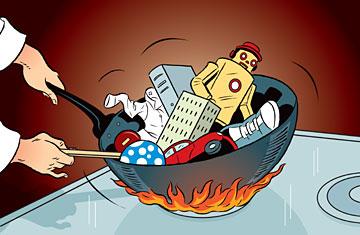
Shanghai, Bangalore, Moscow, Dubai, São Paulo: these are the places generally considered to be the centers of the world's ongoing economic boom. But such is the scale and extent of that boom — annual global GDP growth is projected to average an astonishing 4.9% from 2003 through 2007, a sustained pace that has been matched only once before in the past 100 years — that prosperity is reaching cities and companies few have ever heard of. Consider Yunnan Chihong Zinc. The company is located in Qu Jing, a backwater city in China's Yunnan province, home to numerous mining operators that shovel raw materials into China's industrial furnace. Yunnan Chihong Zinc's main customers are steel and auto producers; business is so good the company has added more than 2,000 employees in the past three years — a 27% increase — and is considering expanding sales to India. Chen Jin, Yunnan Chihong Zinc's CEO, credits China's burgeoning middle class. "The cars they buy, the apartments and other houses they're buying, they are at the center of China's growth, and it's hard to see any real risk to that. We're very optimistic."
Yunnan Chihong Zinc is one under-the-radar example of how the explosion of international trade has spawned a new generation of growth companies in rapidly developing countries. The growing role these companies are playing in the globalized economy is so significant, they've been made the focus of a World Economic Forum (WEF) conference being held Sept. 6-8 in Dalian, China. It's no accident the WEF chose one of the mainland's vibrant coastal cities as the venue. With annual GDP growth averaging more than 10% for the past four years, China is the pace setter for the global economic boom and is minting more than its share of emerging multinational corporations.
The names of a few of these "New Champions" (as the WEF has dubbed them) you may know. There's Lenovo, which acquired IBM's personal-computer business in 2004 and today is one of the world's largest PC manufacturers. Also on the roster is China Ocean Shipping Group (COSCO), an international shipping and logistics giant with $17 billion in annual revenue. But in this TIME report, we decided not to dwell on familiar names. Instead, in the next few pages, we highlight a few fast-growing Chinese companies you have probably never heard of, but may be reading more about in coming years.
Of course, that will happen only if China keeps cooking — and there are gathering threats to the country's extraordinary economic performance. A credit crunch and a slump in the U.S. housing market could weigh on American consumer spending and cut demand for goods produced by export-driven economies like China's. Inflation on the mainland is a worry: the People's Bank of China, the central bank, just increased interest rates for the fourth time this year in an effort to check rising prices and slow expansion to a more sustainable pace. Indeed, the harmful side effects of unbridled growth are showing up with disturbing frequency: Chinese manufacturers producing shoddy, even dangerous, exports have given the country a black eye abroad, while mounting environmental problems are undermining living conditions at home.
These problems may well slow the mainland juggernaut. But skeptics who say China's double-digit growth rate can't last much longer should read their Asian history. In its postwar rise, Japan grew at 9% or more every year from 1955 to 1970. "Barring any unforeseen shocks, either internal or external, it's certainly possible" for China to follow a similar path, says Nicholas Lardy, an economist at the Peterson Institute for International Economics in Washington. And with China leading the way, perhaps the current historic global economic boom, rather than growing long in the tooth, has plenty of room to run.